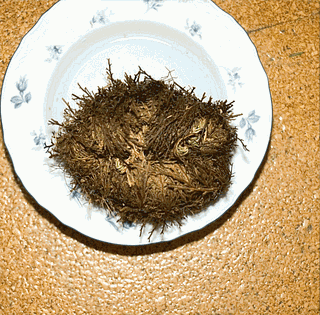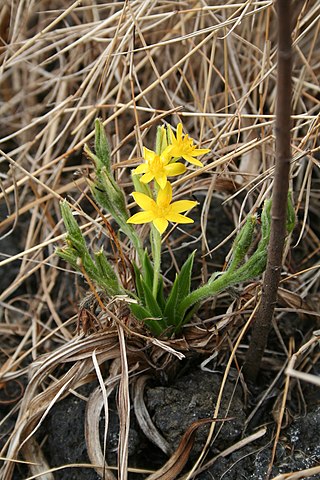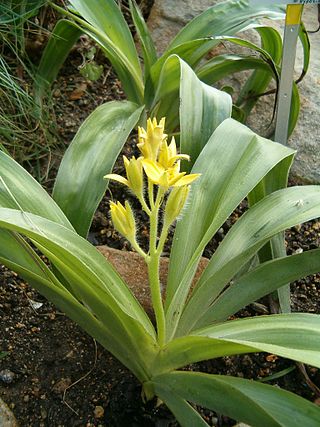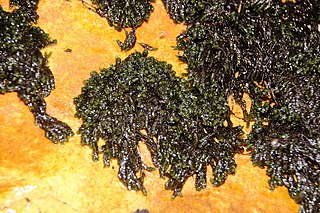
Funaria is a genus of approximately 210 species of moss. Funaria hygrometrica is the most common species. Funaria hygrometrica is called “cord moss” because of the twisted seta which is very hygroscopic and untwists when moist. The name is derived from the Latin word “funis”, meaning "a rope". In funaria root like structures called rhizoids are present.

A resurrection plant is any poikilohydric plant that can survive extreme dehydration, even over months or years.

A plant cuticle is a protecting film covering the outermost skin layer (epidermis) of leaves, young shoots and other aerial plant organs that have no periderm. The film consists of lipid and hydrocarbon polymers infused with wax, and is synthesized exclusively by the epidermal cells.
Star grass is a common name for several plants and may refer to:

Hypoxis hirsuta, commonly known as common goldstar, common star-grass, eastern yellow stargrass, yellow star grass, or yellow star flower, is a perennial ornamental plant in the family Hypoxidaceae. Sometimes this plant is placed in the family Amaryllidaceae or the family Liliaceae. The species is native to the United States, Canada, and northeastern Mexico.

Hypoxis villosa is a plant species in the Hypoxidaceae, formerly included in the Liliaceae or Amaryllidaceae. It is native to southern Africa.

Hypoxis is a genus of flowering plants of the family Hypoxidaceae. The genus has an "almost cosmopolitan" distribution, occurring in Africa, the Americas, Asia, and Australia. Europe lacks native species. Most species are in the Southern Hemisphere, especially in southern Africa. Common names for the genus include star-grass, star lily, yellow stars, African potato, and stars. The genus is the largest of the Hypoxidaceae and has its centre of variation in South Africa, where it occurs in open undisturbed grasslands. The name Hypoxis was taken over by Linnaeus in 1759 from a name coined by Paul Reneaulme in 1611 for a superficially similar species of Gagea and meaning "a little sour", referring to the taste of that plant's leaves.

Hypoxis hemerocallidea, the African star grass or African potato, is a medicinal plant in the Hypoxidaceae family. It is native to southern Africa from South Africa as far north as Mozambique and Zimbabwe. This plant is the best known member of this genus.

The Funariidae are a widespread group of mosses in class Bryopsida. The majority of species belong to the genera Funaria and Physcomitrium.

Wardia is a monotypic genus of mosses in the subclass Dicranidae; it contains only the species Wardia hygrometrica, "an aquatic moss endemic to the Western Cape province of South Africa." It is the only endemic moss family in South Africa. As it is an aquatic moss, it was first classified in the Fontinalaceae, but molecular studies have shown that it is more closely related to the Dicranaceae.

Funaria hygrometrica, the bonfire moss or common cord-moss, is a type of water moss which grows on shady, moist soil. It can also be found on moist walls and the crevices of rocks and places where recent fires have taken place. It has been reported to grow in Niagara Cave, an artificially illuminated cave devoid of natural light. Under such conditions, its growth form changes so that the internodes lengthen and the leaves become longer and narrower.
Werauhia hygrometrica is a species of flowering plant in the Bromeliaceae family. It is native to Costa Rica, Mexico, Venezuela and Ecuador.
H. gardneri may refer to:

Boea is a genus of plants in the family Gesneriaceae, with species originating from Australia, China, India, Malaysia, Myanmar, Philippines, Polynesia, Solomon Islands, Thailand, Papua New Guinea, Indonesia, Nepal, Bhutan, Cambodia, Vietnam and Laos.

Rhodohypoxis is a small genus of tuberous flowering plants in the family Hypoxidaceae, native to southern Africa. The small flowers, no more than 15 cm (6 in) high, are constructed so that their centres are not visible. Some species are in cultivation.
Hypoxis mexicana, common name Mexican yellow star-grass, is a small herbaceous plant. It is widespread across much of Mexico, and has also been reported from southern Arizona.

Hypoxis juncea is a star-grass species with leaves that are so narrow as to be comparable to thread. It is not a true grass, despite the common name. It is found in the United States on coastal plains from Florida + Alabama to North Carolina. The species is a facultative wetland perennial forb.

The Gippsland Plains Grassy Woodland is an ecological temperate grassland community located in the Gippsland region in southern Victoria, Australia. Stretching from Bairnsdale in the east to the eastern portion of Melbourne in the west, they typify one of Victoria's most threatened and disconnected indigenous ecosystems. The Gippsland Red Gum Grassy Woodland is the most prominent community in the system situated in the centre.













